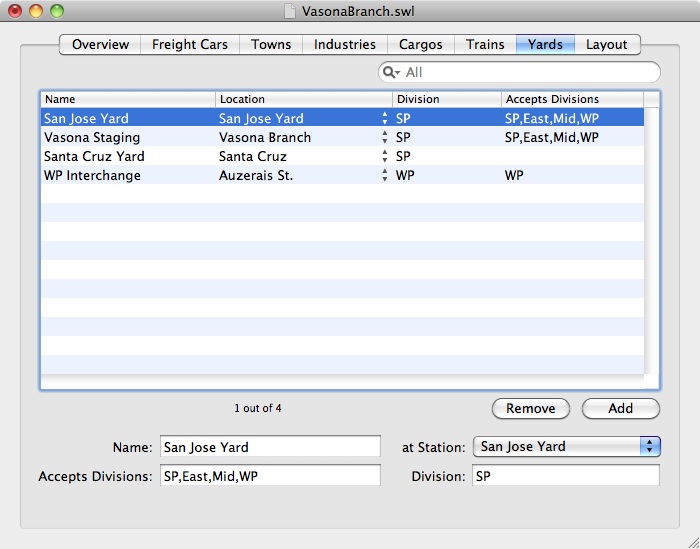 The Yards tab lets declare which
railroad yards, staging tracks, and interchanges exist on your
railroad.
The Yards tab lets declare which
railroad yards, staging tracks, and interchanges exist on your
railroad.
To add a new Yard, press the "Add" button. You'll need to give the yard a name, and specify the town it is in. You can remove unneeded yards with the "Remove" button.
Yards are important for three reasons: first, all trains must begin and end in a town with a yard. Second, yards provide a place for cars to be exchanged between trains if a freight car cannot be moved from source to destination in a single step. Third, empty freight cars will go to a yard for storage.
The "Accepts Divisions" and "Division" fields for yards affect when cars can be exchanged between trains and where empty cars go. The "Division" field names which railroad owns a yard; empty cars with the same division will try to go to that yard. If a yard's "Division" field is blank, then any freight car that is empty may go there. If the freight car's "Division" is blank, then it will go to any yard when empty.
The "Accepts Divisions" indicates which cars can temporarily be placed in that yard while switching trains. Generally, a freight car with a non-blank "Division" can only be exchanged in yards that accept that division. Yards with blank "Accept Divisions" fields will accept any car.
Yards in towns that are marked as staging (not on the visible layout) behave slightly differently; any freight car making it to a yard in staging are assumed to have reached their next destination. If empty, the car is assumed to have reached its owning railroad. If the car is loaded, then the car has reached its final destination. If the car is empty but reserved for a load, then the car has reached its initial destinatio and will be loaded and sent off to the cargo's destination.
Detail Divisions for cars and industries